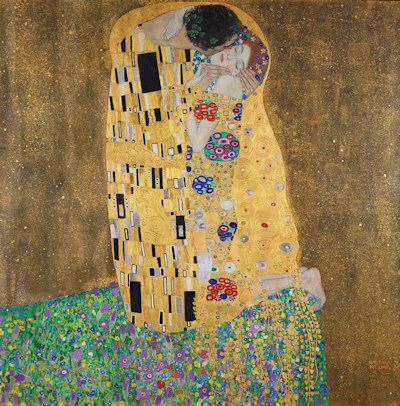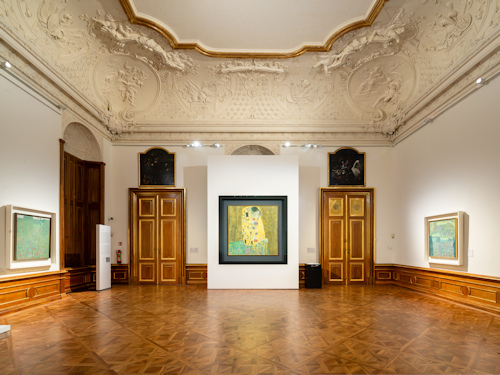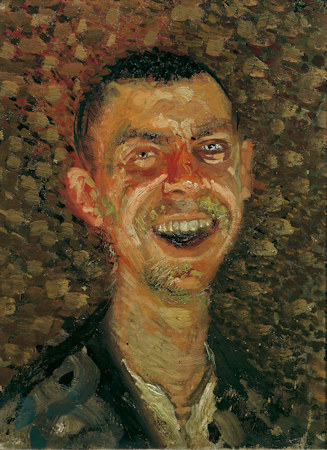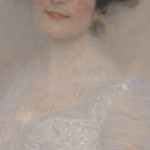What are the world’s most famous paintings? Good question. All I can say is when you reach the first floor on the grand staircase of Upper Belvedere palace, you are just a few steps from one of them: Gustav Klimt’s The Kiss.
- World-leading collection of Klimt paintings
- Also masterpieces by the likes of Schiele, Rodin, and Makart
- Thematic galleries make for an educational experience
- The Belvedere is a dynamic museum, so the actual works on display may change!
- Book Upper Belvedere tickets* online
- See also:
The exhibition

(The Kiss by Gustav Klimt. The painting that launched a thousand souvenir shops. Photo courtesy of and © Belvedere, Wien. Reproduced with permission under the terms of Creative Commons License CC BY-SA 4.0.)
The gallery rooms displaying the Vienna 1900 and Klimt collections curl around the first floor of Upper Belvedere palace, beginning off the glorious Marble Hall and returning you to the giant staircase.
Each gallery presents a theme, reflected in the choice of art displayed within. Though broadly chronological, one theme might be The Secession, another Psyche and Provocation (this is where you know some serious art lies ahead).
The collection takes you through Viennese art at the turn of the century, starting at the end of the 1800s and finishing with the transition toward modernity. And all with a significant presence for works by Gustav Klimt.
Most visitors to Belvedere congregate in this part of the palace, so you may find quite a few others browsing the art with you.
Such an extraordinary era makes for an extraordinary exhibition, which in turn makes it hard to pick out the highlights. But I will simply mention two personal ones…
Klimt

(Gustav Klimt’s unfinished portrait of Amalie Zuckerkandl from 1918; press photo: Johannes Stoll / Belvedere, Vienna)
Nowhere in the world can offer Klimt quite like the Belvedere.
I counted around a dozen paintings in passing on my last visit (and I’ve seen 16 at other times), though a nice golden painting tucked away in one room caught my particular attention.
Actually, you’ll likely spot The Kiss through the numerous smartphones held in front of it. There is something decidedly thrilling about standing so close to such an iconic and world-famous image.
The painting stands within a stark, black frame, pulling your eyes around its component parts. If Austria ever runs up too much public debt, this one painting alone might clear it for them.

(The Kiss occupies pride of place in the exhibition; press photo: Lukas Schaller / Belvedere, Wien)
Incidentally, if you’re here on Valentine’s Day, Belvedere normally offers couples a special photographic treat.
Other works by Klimt also deserve your attention, though. His wonderful Judith from 1901, for example, casts her arrogant eyes across one room, though she sometimes disappears at intervals for exhibitions elsewhere.
Tip: if you want to find other Klimt works in Vienna, see this guide, which also mentions notable special exhibitions featuring his art.
Portraits
The Vienna 1900 section also includes a number of startling portraits.
For example:
- Egon Schiele’s 1910 Eduard Kosmack. The sitter’s intense gaze seems to penetrate into your very soul. Which is rather alarming, when you’re just enjoying a nice day in Vienna and looking forward to an ice cream later
- Richard Gerstl’s 1907/1908 portrait of himself laughing. As you might expect, not a blithe, easygoing kind of laugh at all for this tourtured creator
- Kolomon Moser’s own self-portrait from around 1915. Another set of eyes that has you looking over your shoulder

(Eduard Kosmack by Egon Schiele. Don’t switch the lights out after viewing. Photo courtesy of and © Belvedere, Wien. Reproduced with permission under the terms of Creative Commons License CC BY-SA 4.0.)
And the rest…
Other works read like a who’s who of Austrian and international art in the late 1800s and early 1900s. Names like Rodin, Edvard Munch, Max Klinger, Oskar Kokoschka, Claude Monet, Hans Makart, and many more.
Consider this section of Belvedere a treasure trove for those interested in that period of creative brilliance that was Viennese art around 1900.
(And, frankly, seeing The Kiss is worth the entrance ticket alone.)

(Richard Gerstl, self-portrait, “laughing” apparently, 1908; press photo: Belvedere, Wien)
Bonus: the chapel
Incidentally, the room that once housed a library offers a peek down onto a small balcony that itself looks over the Belvedere chapel. The latter is small in size, but big on Baroque splendour…rich in white, gold and brown marble.
The balcony would be where Belvedere’s owner (Prince Eugene) could enjoy services privately.
Piety is all well and good, but you wouldn’t want to get cold while saying your prayers: the balcony had its own fireplace to add a little warmth to religious proceedings.
This private space also meant, of course, that Eugene needn’t mix with the rabble below and could, presumably, throw fruit at itinerant members of his household staff if he got bored.
I have no historical evidence to suggest that he did this.
(But I bet he thought about it.)
Next on your trip around Upper Belvedere: the Emerging Modernism and The Avant Garde sections.
